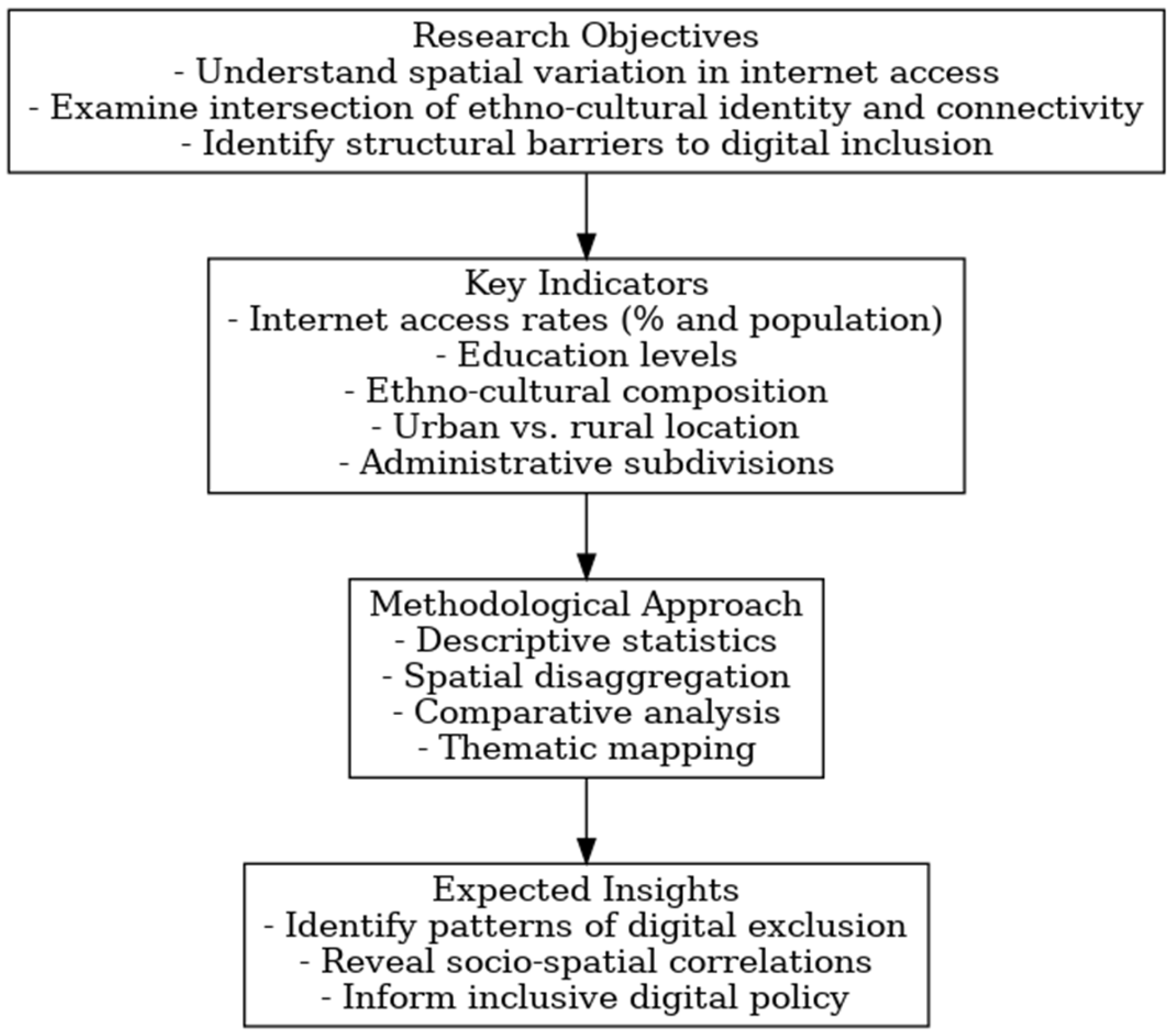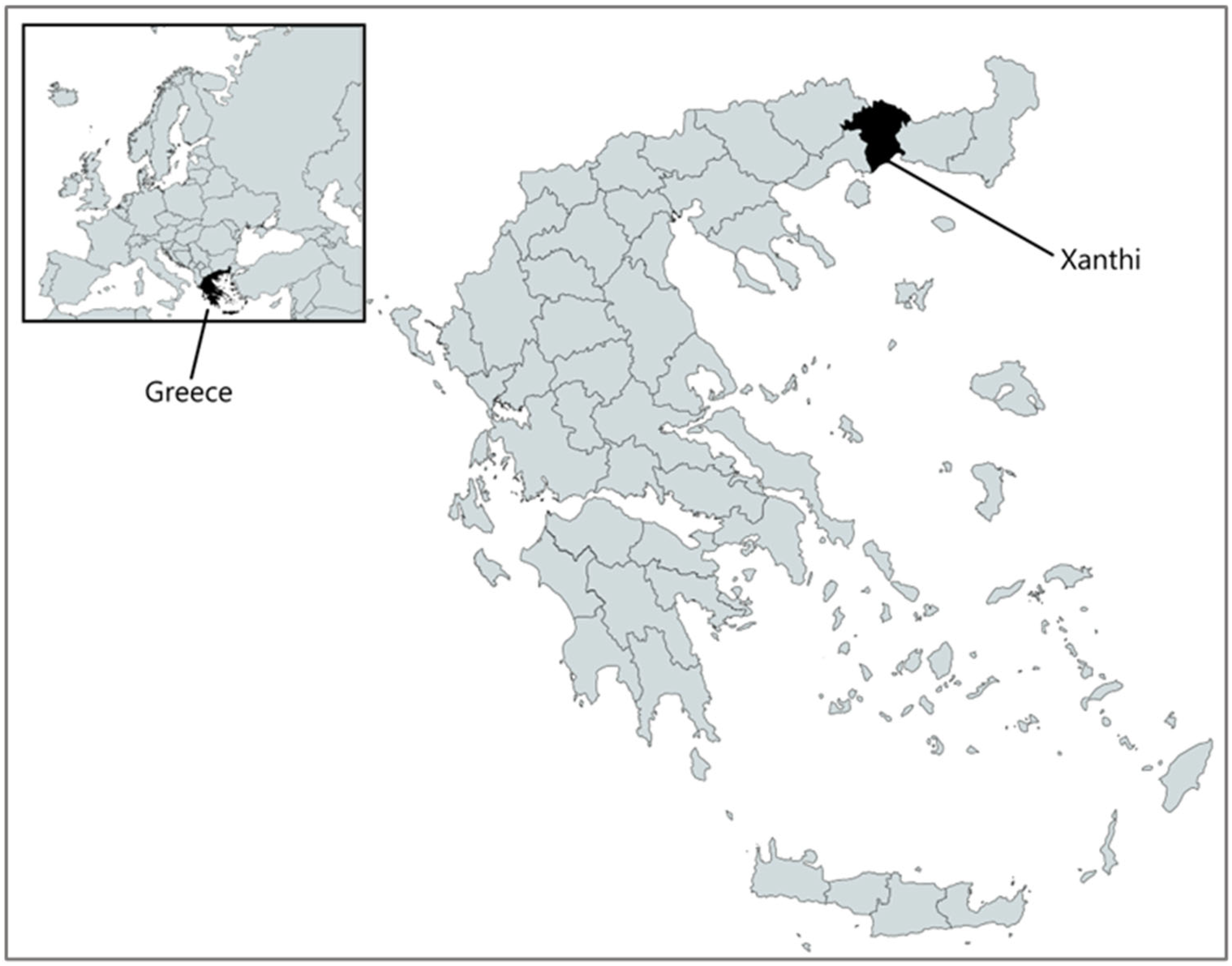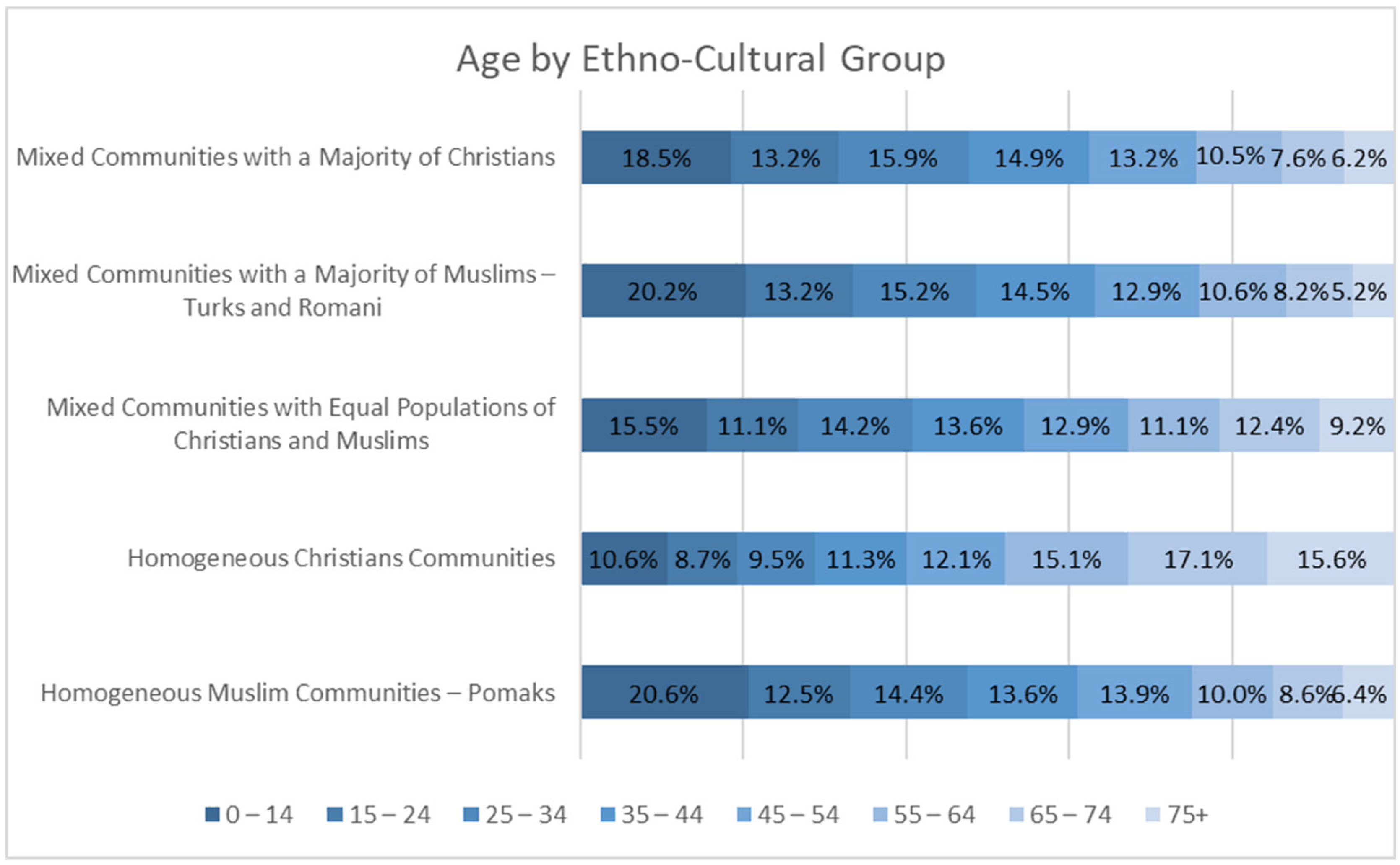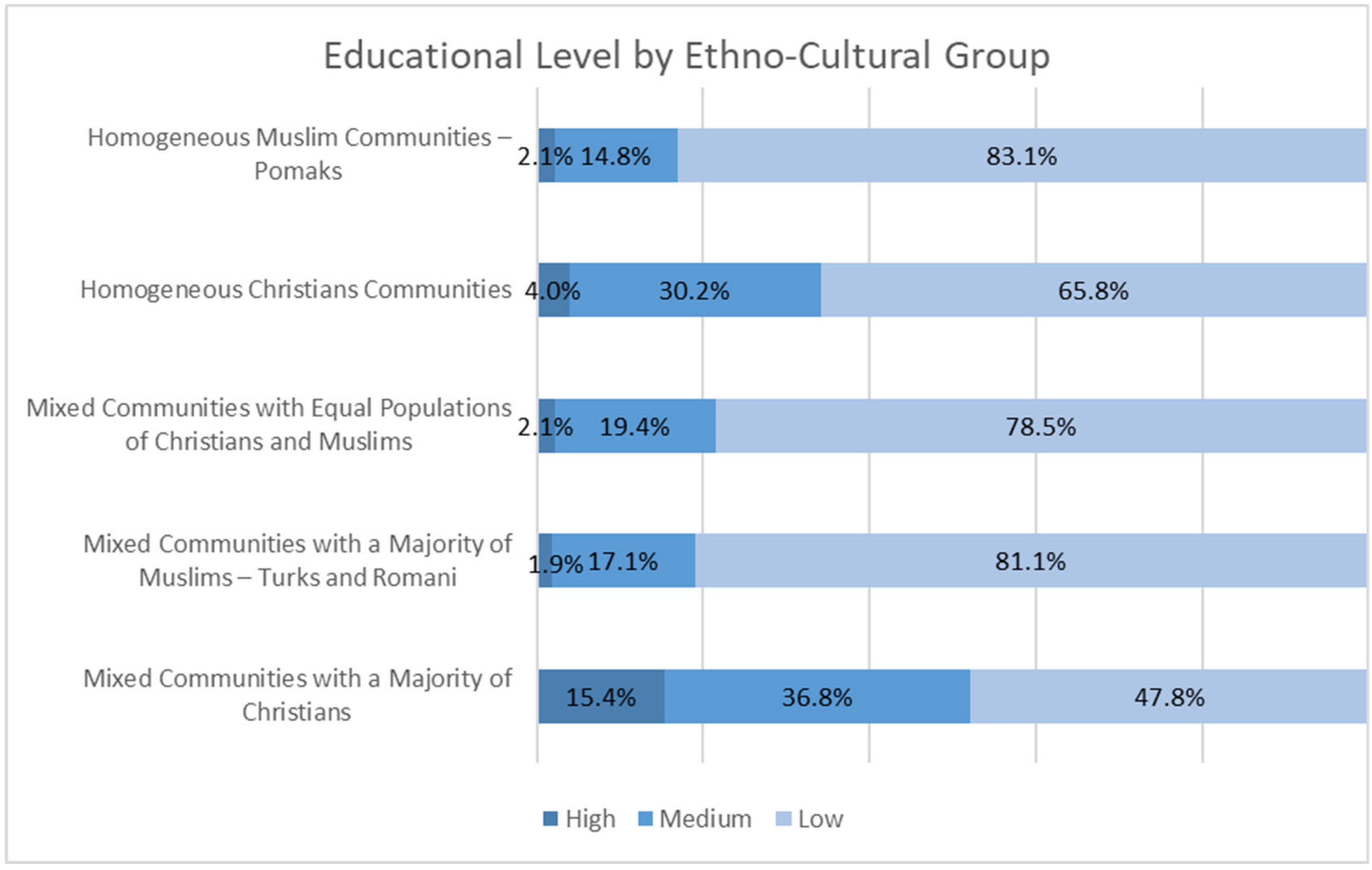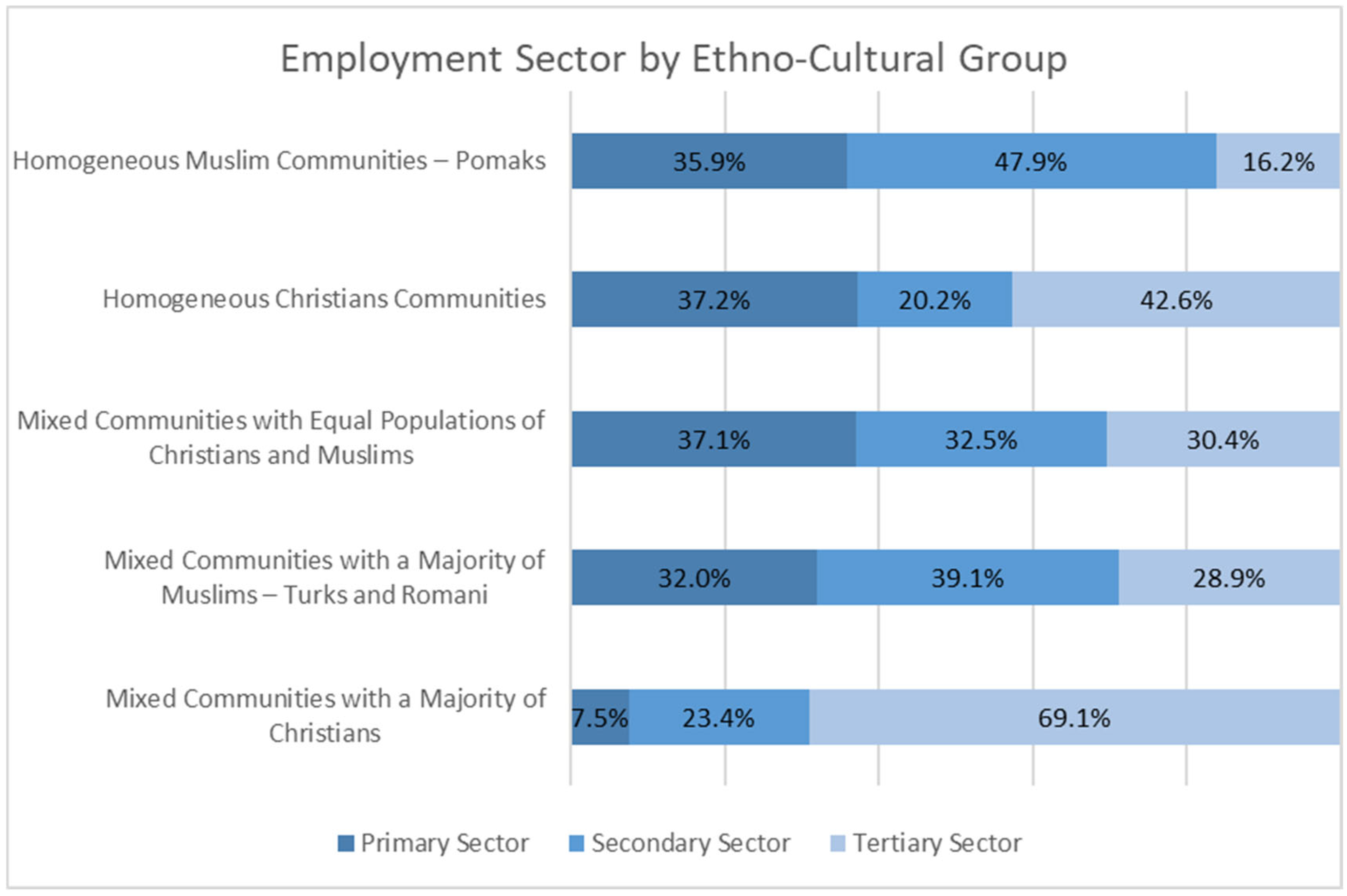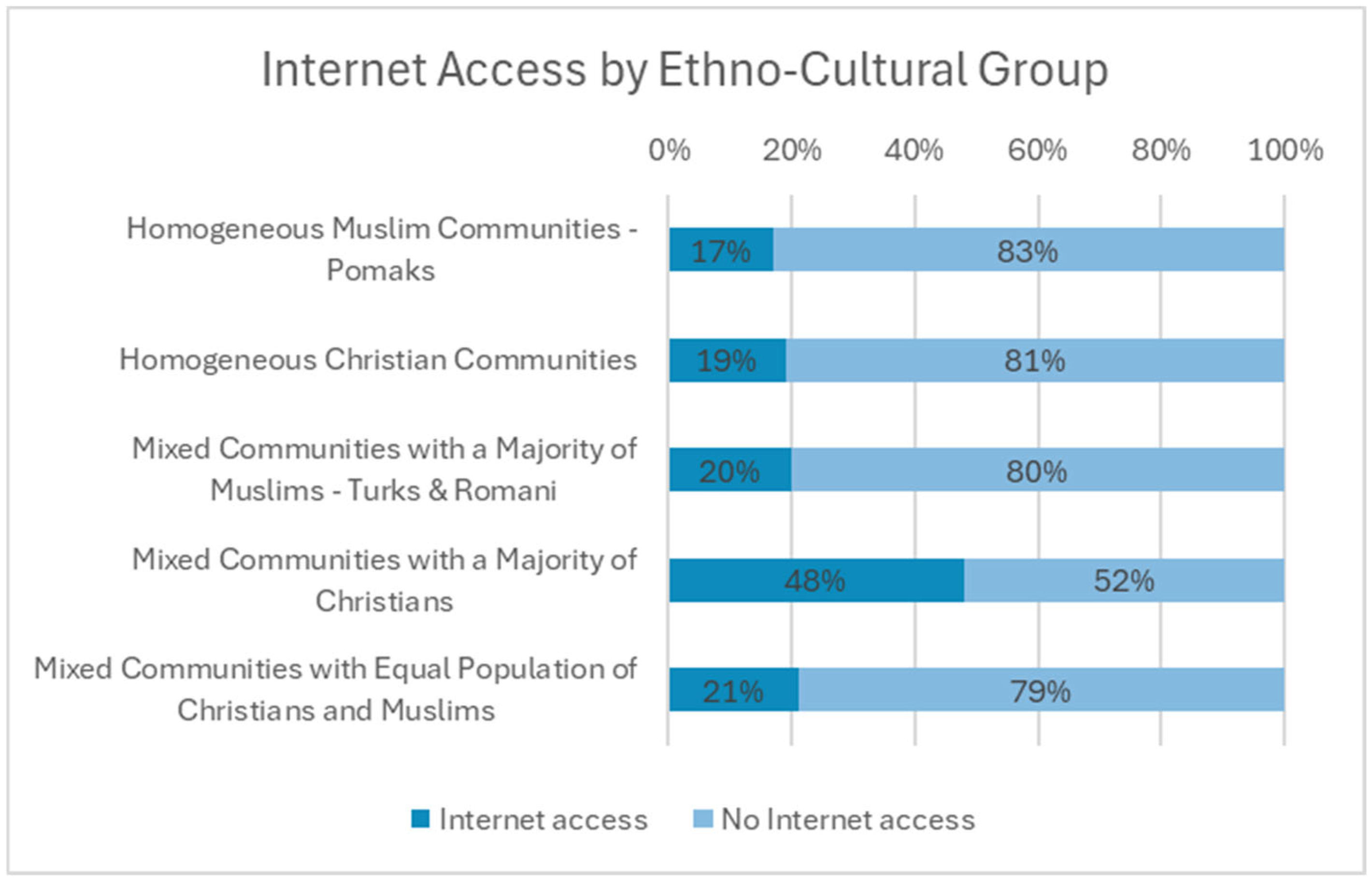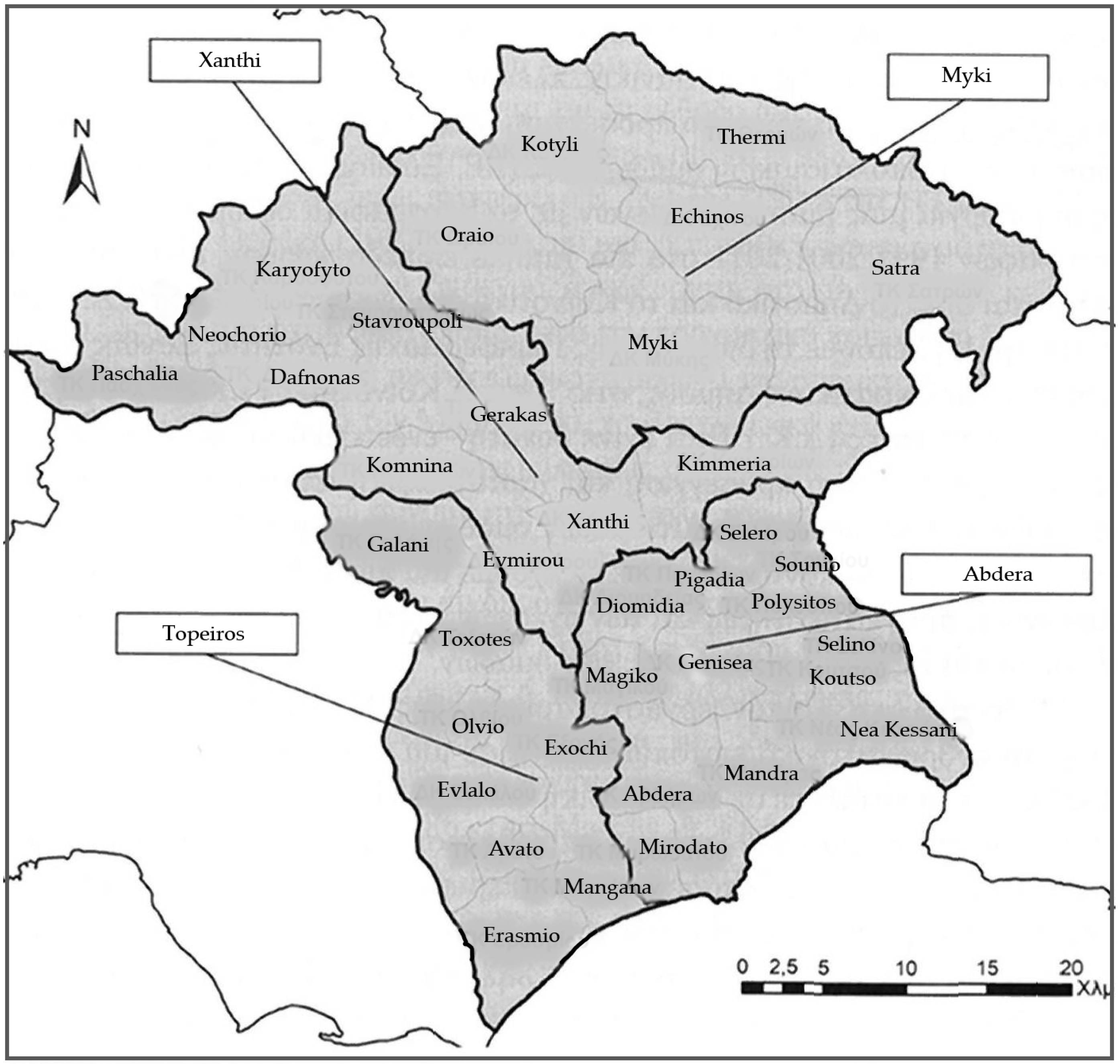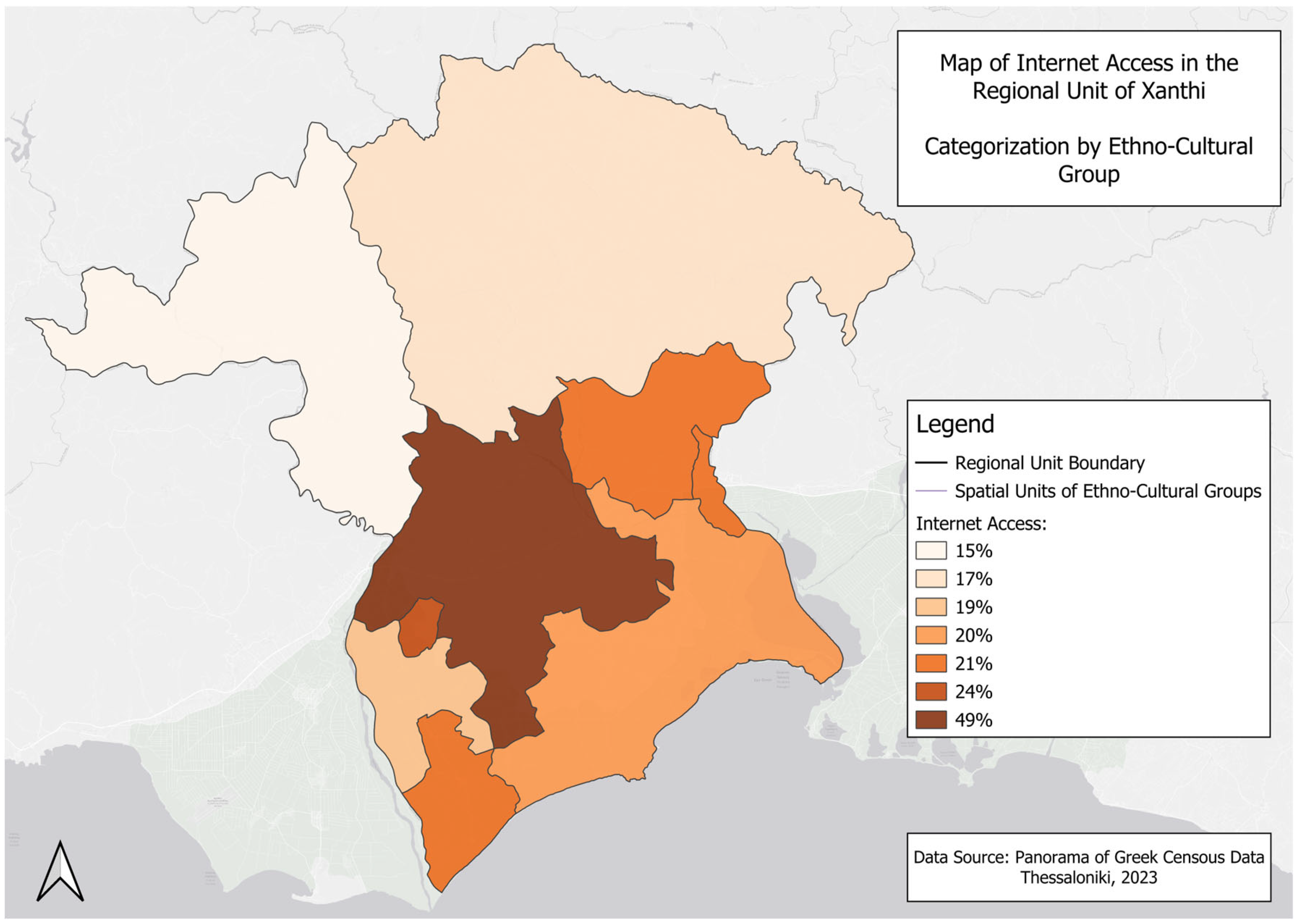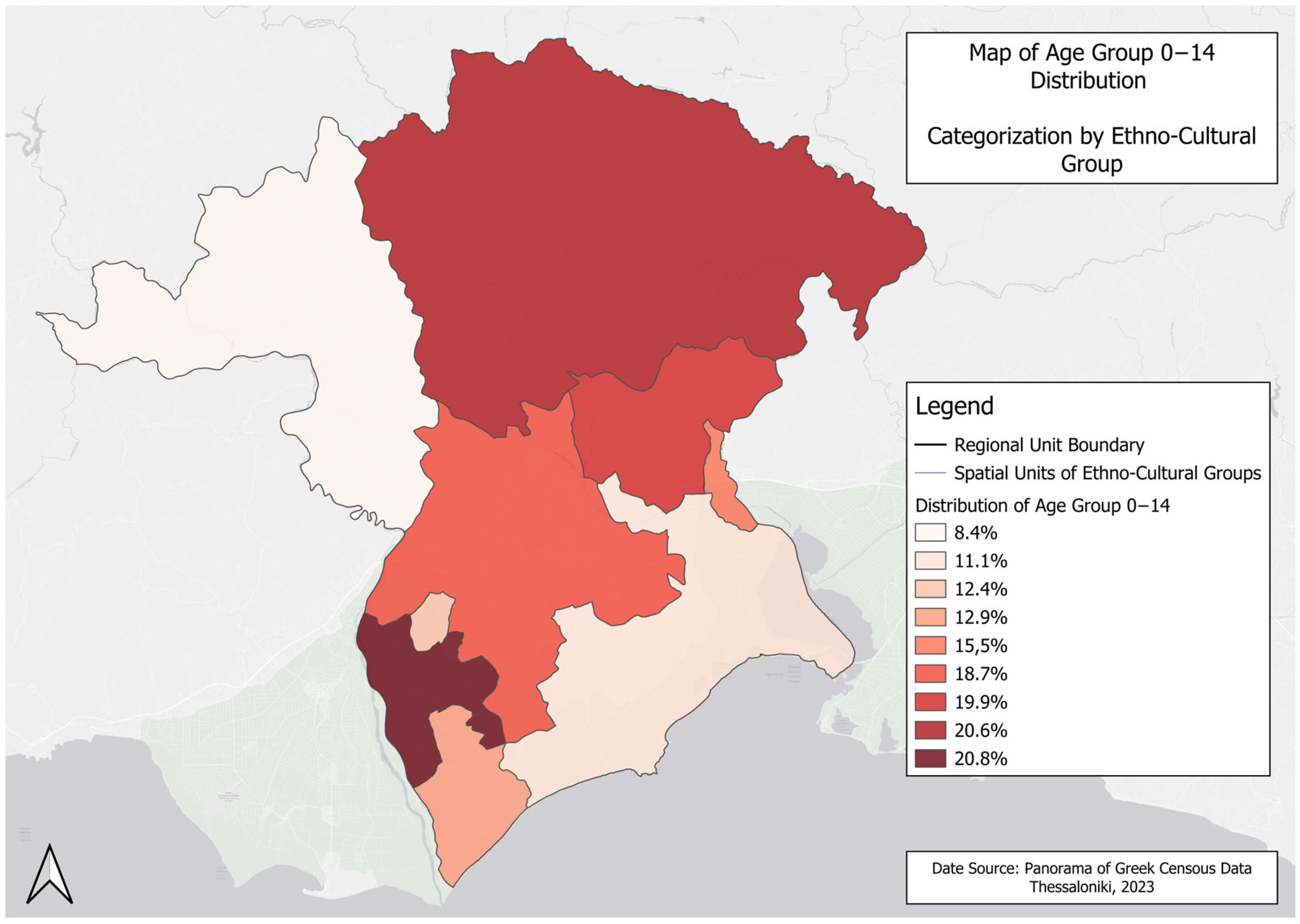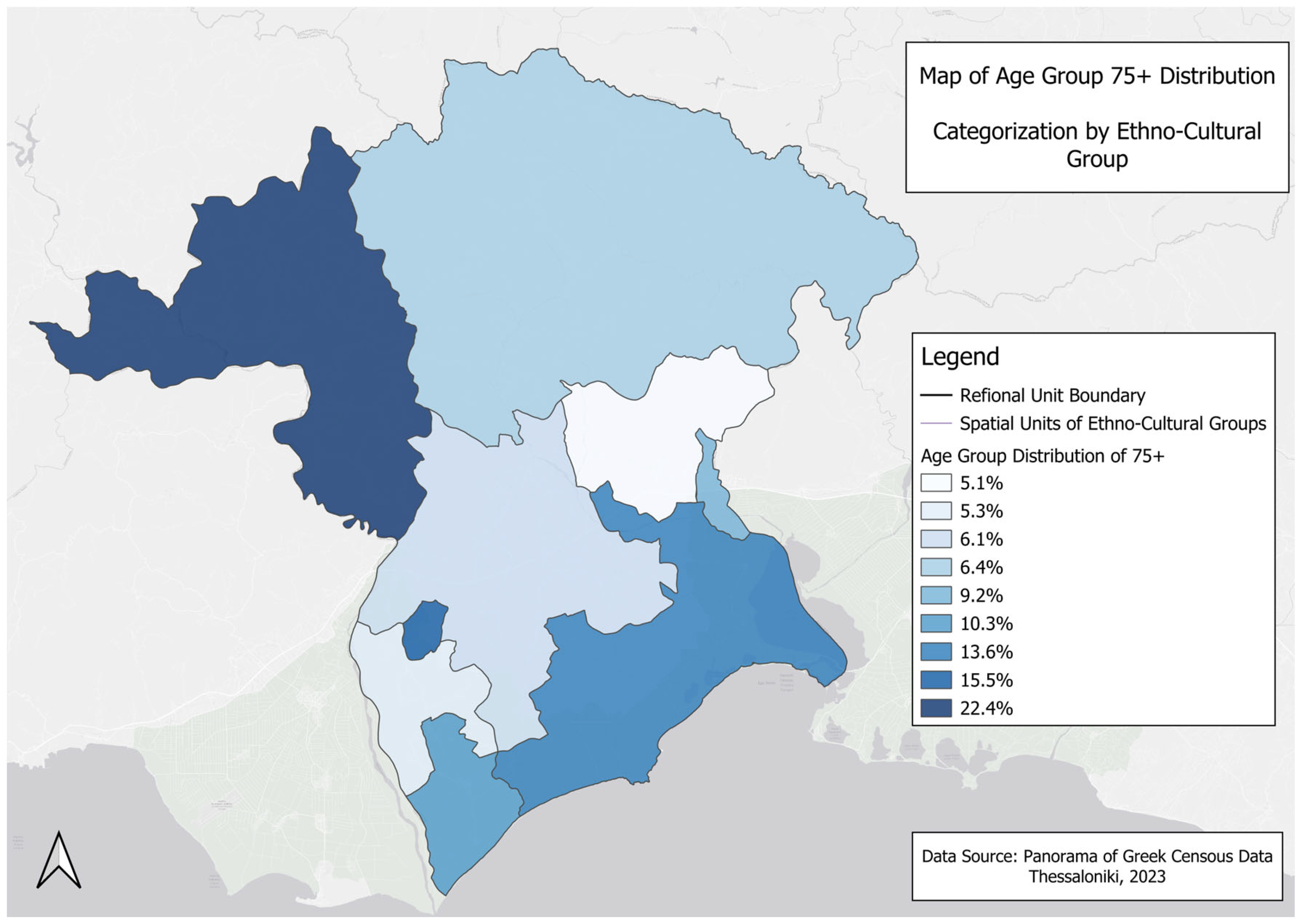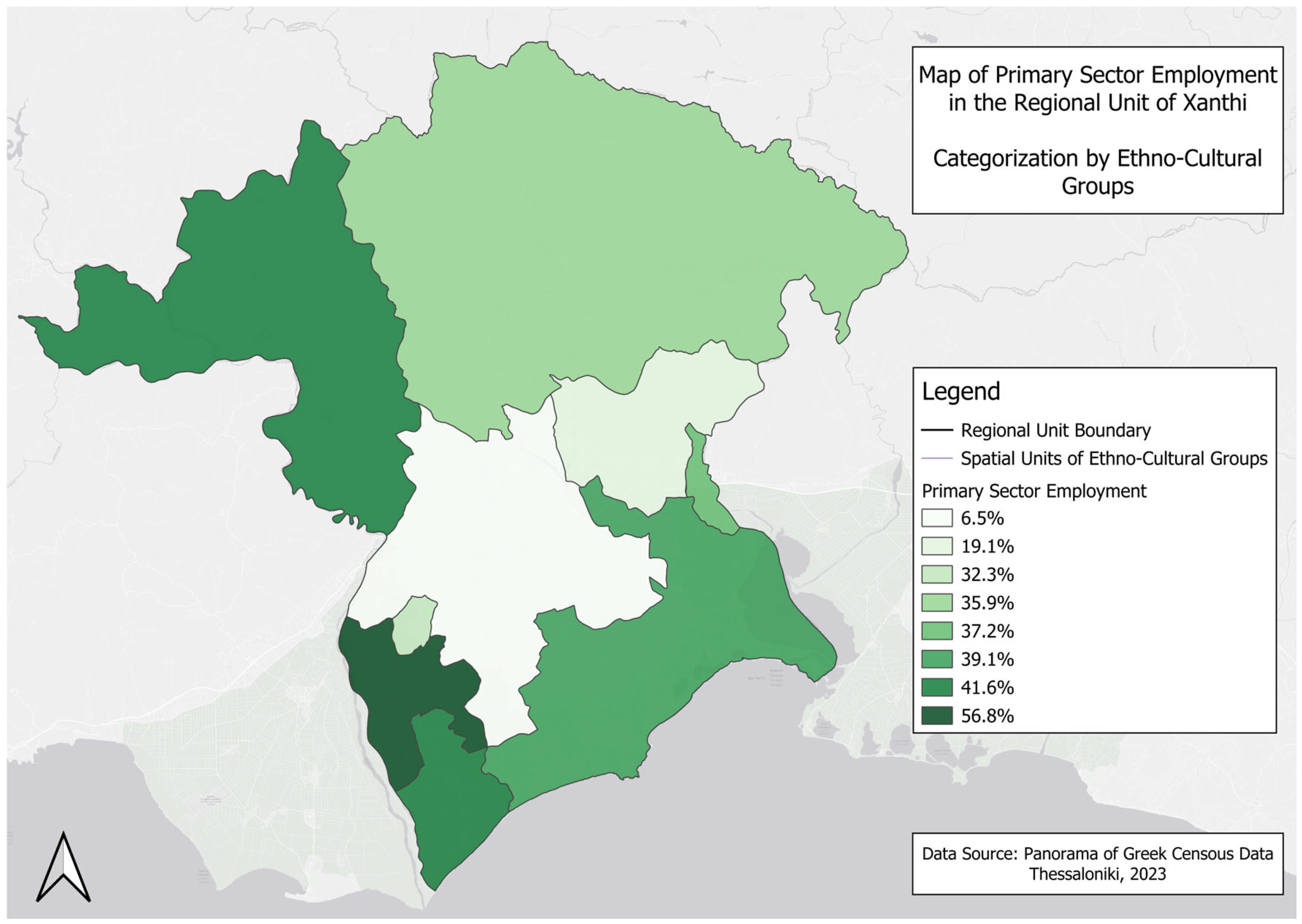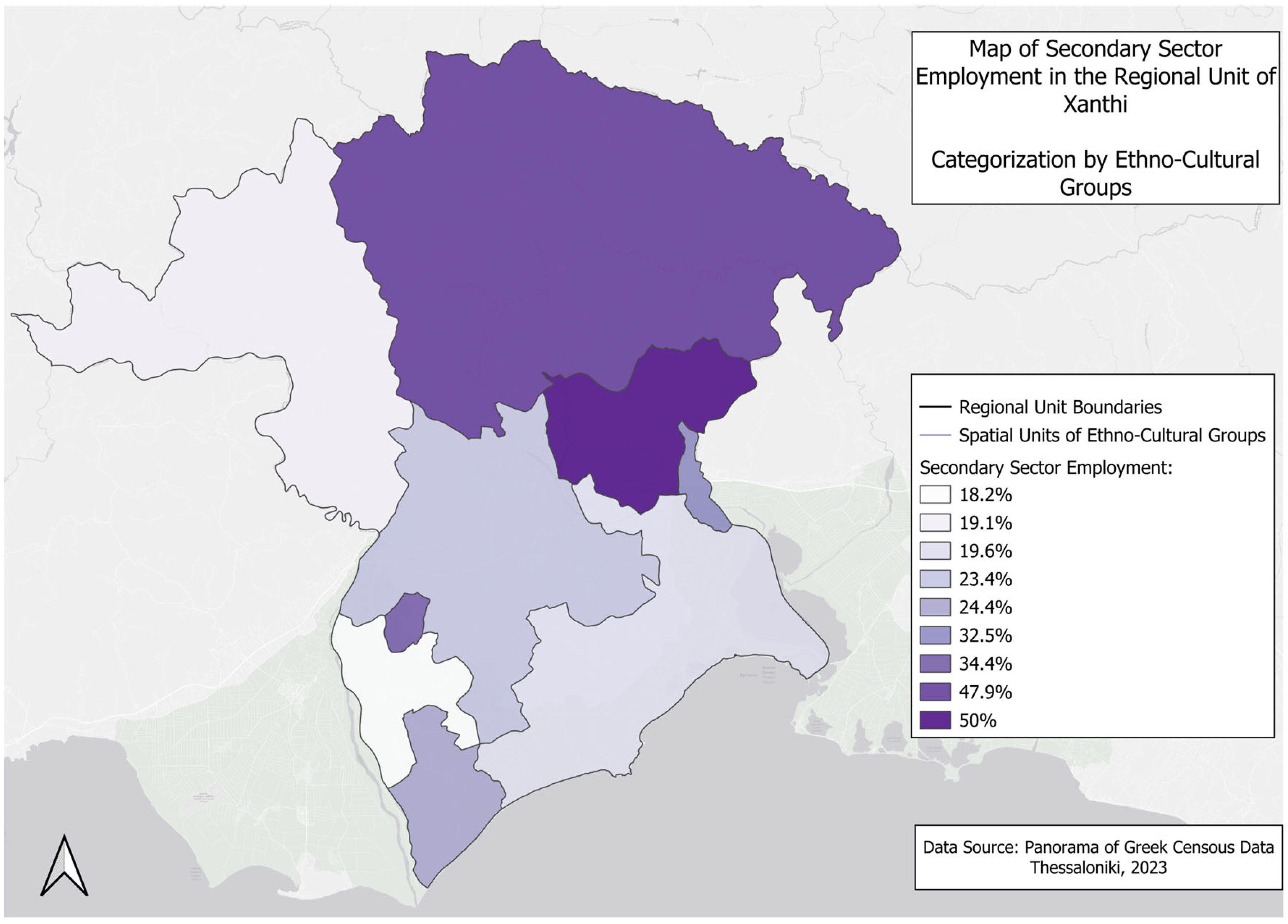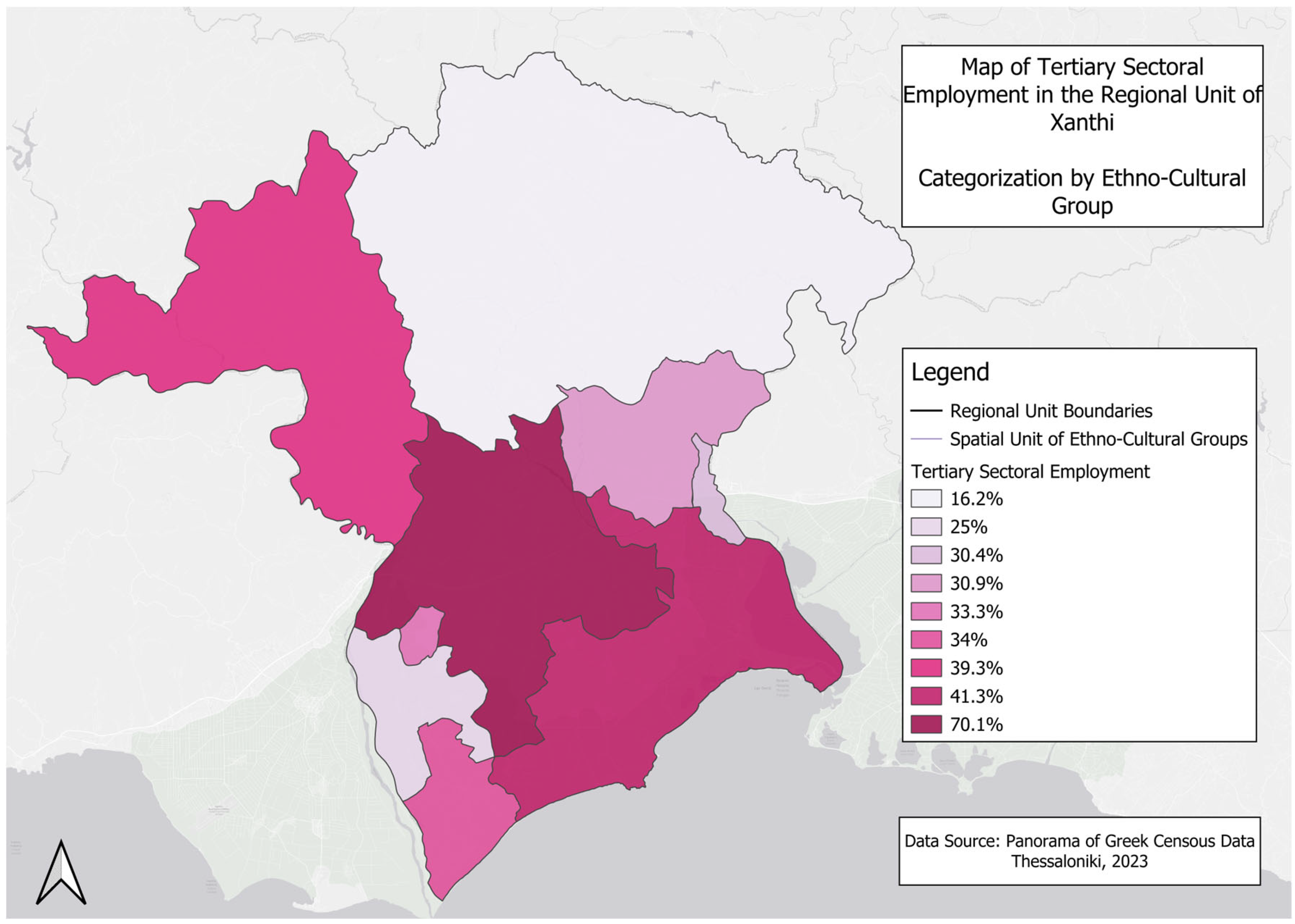3.1. Quantitative Analysis
The findings presented in
Table 1 highlight significant disparities in internet access across the Regional Unit of Xanthi and its municipalities. Including absolute population figures alongside internet access rates provides important context for interpreting spatial patterns of digital inequality. In small communities such as Paschalia (82 residents), Gerakas (270), and Galani (98), even minor fluctuations in access can result in large percentage changes, potentially exaggerating disparities. These cases highlight the need to consider demographic scale when evaluating connectivity gaps, as low population density often compounds infrastructural and service limitations in rural areas.
Overall, only 38% of the population in the Regional Unit of Xanthi has access to the internet, while 62% remains without access. The municipality-level data reveal striking contrasts: the Municipality of Xanthi, classified as urban, has the highest internet access rate at 48%, followed by Abdera (27%), Topeiros (21%), and Myki, with the lowest rate at just 17%. Within municipal units and local communities, these disparities become even more pronounced. For example, areas like Diomidia (41%) and Magiko (40%) report higher access rates, while remote and rural areas such as Thermi, Kotyli, and Paschalia report no internet access (0%). Similarly, in Myki Municipality, Oraio and Satra show internet access rates of only 5% and 1%, respectively.
The urban–rural divide is evident, with urban areas like Xanthi city (51%) exhibiting relatively higher connectivity compared to extremely underserved regions, including Selino (1%) and Dafnonas (16%). The data also reflects socio-economic and infrastructural disparities that influence access, emphasizing the need for targeted interventions to bridge these gaps and promote equitable digital participation across the region.
Figure 4 shows the age distribution across different ethno-cultural groups in the study area. Homogeneous Muslim Communities have a notable concentration of younger age groups, with the 0–14 age group at 20.6%, while older age groups, particularly 75+ (6.4%), are much smaller. In contrast, Homogeneous Christian Communities display a larger proportion of older populations, with the 65–74 age group at 17.1% and the 75+ age group at 15.6%, reflecting an aging demographic. Mixed communities with an equal population of Christians and Muslims exhibit a balanced distribution, with the highest concentration in the 25–34 age group (14.2%), while the older age groups are less prominent. Similarly, Mixed communities with a majority of Muslims (Turks and Romani) also show a younger demographic, with the 0–14 age group accounting for 20.2%, and the 75+ group being the smallest (5.2%). Finally, mixed communities with a majority of Christians reflect a slightly older population, with higher proportions in the 35–44 age group (14.9%) and relatively lower percentages in the younger 0–14 group (18.5%). Overall, the diagram highlights that younger age groups dominate in Muslim-majority areas, while Christian-majority areas exhibit a more aging population, particularly in homogeneous communities.
Figure 5 presents aggregated educational attainment grouped into three categories: low (including below primary, primary, and compulsory education), medium (comprising secondary and post-secondary education), and high (encompassing tertiary and postgraduate education). The data reveal pronounced disparities across ethno-cultural groups. Homogeneous Muslim communities and Muslim-majority mixed areas show the highest shares of low education levels (83.2% and 81.0%, respectively), with minimal representation in the high category. In contrast, homogeneous Christian and Christian-majority mixed communities display significantly greater shares in medium and high educational attainment—most notably, 15.4% of residents in Christian-majority mixed communities have completed tertiary or postgraduate education. These differences illustrate how educational inequality aligns with broader patterns of socio-spatial and ethno-cultural exclusion.
Figure 6 highlights employment sector differences across ethno-cultural groups. Homogeneous Muslim Communities and Muslim-majority mixed communities rely heavily on the Secondary and Primary Sectors, with limited engagement in the Tertiary Sector. In contrast, Homogeneous Christian Communities and Mixed Christian-majority communities show higher employment in the Tertiary Sector, with the latter reaching 69.1%, reflecting a service-oriented economic profile. The data reveal a clear divide, with Muslim-majority and rural communities more dependent on primary and secondary production, while Christian-majority groups are more integrated into the tertiary sector. These disparities highlight the urgent need for context-aware smart inclusion policies tailored to the needs of rural and multiethnic populations.
3.2. Spatial Analysis
The spatial analysis draws on two overlapping but distinct scales: (1) administrative boundaries (municipalities and local communities), which correspond to institutional structures and infrastructural planning, and (2) ethno-cultural groupings, which reflect the social and demographic realities that influence digital behavior and exclusion. By working across these two spatial lenses, the analysis captures both formal governance frameworks and informal socio-cultural dynamics, offering a more nuanced understanding of how digital inequality is produced and experienced in the region
Figure 7 illustrates significant disparities in internet access among ethno-cultural groups within the studied region.
Homogeneous Muslim communities exhibit the lowest internet access rate (17%), followed closely by homogeneous Christian communities (19%) and mixed communities with a majority of Muslims (20%). In contrast, mixed communities with a majority of Christians have the highest internet access rate (48%), indicating better infrastructural and socio-economic conditions. Mixed communities with an equal population of Christians and Muslims show slightly higher access (21%) but remain closer to the access levels of the most disadvantaged groups. These findings underscore the influence of socio-spatial and ethno-cultural factors on digital inequality, with Muslim and rural communities facing significant exclusion, emphasizing the need for targeted policies to address these disparities.
While urban centers, particularly the city of Xanthi, are predominantly inhabited by Christian-majority populations, there are also Christian communities in mountainous rural areas, especially in the northwestern part of the region. Conversely, Muslim groups (including Pomak and Romani communities) are primarily concentrated in rural and semi-rural areas, with limited representation in the urban core. This uneven spatial distribution intersects with both ethnic and urban–rural divides, making it important to distinguish between their respective influences on digital access.
The spatial analysis that follows illustrates internet access across the entire Regional Unit of Xanthi, highlighting the boundaries between the spatial units of each ethno-cultural group, as shown in
Figure 3, and subsequent representations. The categorization of these spatial units is based on the boundaries of Municipal Units and Local Communities, as depicted in
Figure 8.
The maps that follow provide a combined representation of internet access alongside ethno-cultural groups and variables such as age groups, education levels, and employment sectors. The difference, however, compared to the aggregated data presented above, is that, for the ethno-cultural categories encompassing two or more spatial units, the data were calculated separately. This approach allows conclusions to be drawn not only about ethno-cultural composition but also about geographical location factors that may influence and differentiate the results. The mapping of internet access by ethno-cultural group and spatial unit reveals a multi-layered exclusion pattern not captured in previous national-level digital divide statistics. This finding underscores the importance of spatially disaggregated analysis in understanding the fine-grained dynamics of digital exclusion in multi-cultural rural contexts.
Figure 9 shows the level of internet access across various spatial units. Among areas with a majority Christian population, notable differences emerge. The unit, including Xanthi, has the highest access rate at 48%, while the southern region, covering the local communities of Erasmio and Avato, reports only 21% access. The lowest access rate, at just 15%, is found in the northwestern unit with predominantly Christian residents, contrasting with the higher access observed in the southern part of the same ethno-cultural group. The northwestern area is characterized by mountainous villages, some of which are remote and only accessible via provincial roads, making connectivity a significant challenge.
The analysis of
Figure 10 and
Figure 11 explores the relationship between internet access rates in specific age groups within the Regional Unit of Xanthi. A key finding is the significant variation in internet access across spatial units, influenced by age demographics and geographical characteristics. Areas with predominantly Christian populations show higher proportions of older age groups and correspondingly lower internet access. For example, the northwestern mountainous unit, which has the highest proportion of residents aged 75 and above (22.4%), records the lowest internet access rate (15%). Conversely, younger populations are more prevalent in ethno-cultural groups such as Pomak and Romani-majority areas, where children aged 0–14 dominate. Despite their younger demographic, these areas still face low internet access, such as 17% in Pomak regions.
In mixed Christian–Muslim populations, younger age groups dominate, with the highest access rate (48%) found in areas with a Christian majority. However, the southern Christian-dominated units report lower internet access (21%) and a relatively older population. These findings highlight the interplay between aging populations and limited digital infrastructure, particularly in remote and rural areas. Ultimately, the analysis underscores how demographic and socio-spatial factors combine to shape digital inequality, revealing distinct patterns of exclusion and highlighting the need for targeted interventions.
Across the analysis of age group distribution compared to internet access levels by spatial units of ethno-cultural groups, mixed patterns emerge. In some cases, the hypothesis linking an aging population to reduced internet access is confirmed, as seen in the mountainous areas predominantly inhabited by Christians. However, in other cases, no such correlation is observed, such as in the Pomak villages and the lowland areas predominantly inhabited by Muslims, Turks, and Romani, where populations are consistently younger with lower aging indices. In the spatial unit that includes the city of Xanthi, which reports the highest internet access rates, the population is also generally younger.
Figure 12,
Figure 13 and
Figure 14 present the relationship between internet access rates in the primary, secondary, and tertiary sectors in the study area. The western region, predominantly inhabited by Muslims, Turks, and Romani, has a striking 56.8% of its population working in the primary sector, representing more than half the total. Similar trends are observed in other areas, including the Pomak villages, mountainous Christian-majority regions, southeastern Christian-majority areas, and mixed regions with equal populations of Muslims and Christians. These areas also share low internet access rates.
In contrast, the mixed Christian-majority areas that include the urban center of Xanthi demonstrate a different pattern. Here, only 6.5% of the population is employed in the primary sector, while an impressive 70.1% work in the tertiary sector. This highlights the urban–rural divide, with higher internet access strongly linked to employment in the tertiary sector.
Across most regions, excluding the mixed Christian-majority areas, low internet access coincides with low educational levels, with primary school graduates as the largest group. In the mixed Christian-majority area that includes Xanthi, the educational profile is notably different, with high school graduates forming the largest group and significantly more university graduates present. Disadvantaged areas are consistently characterized by a high reliance on the primary production sector for employment.
This spatialized understanding supports the development of place-sensitive smart inclusion strategies that bridge infrastructural and demographic divides.
3.3. Qualitative Analysis
A total of thirteen interviews were conducted, focusing on participants’ access to technology, their attitudes toward digital tools, motivations behind their internet usage, and barriers they face. The findings provide a rich and nuanced understanding of digital inequality in the Regional Unit of Xanthi, where geographical location, age, occupation, and socio-economic conditions collectively shape the digital landscape.
A prominent theme in the interviews is the generational divide in digital access and use. Younger participants, particularly students such as P1, P2, and P3, viewed technology as essential to their studies and daily lives. P1 highlighted the convenience of technology: “Faster internet helps me complete my university assignments quickly and efficiently.” These participants demonstrated confidence in navigating digital tools, using them not only for academic purposes but also for communication and entertainment. Similarly, P10, a student and worker, emphasized the role of self-taught digital skills, stating the following: “Online communities have helped me understand technology better; you learn a lot from others who share their knowledge.” This showcases the adaptability and resourcefulness of younger generations in embracing digital platforms.
In contrast, older participants, including P4 and P5, both retirees from Stavroupoli, expressed reluctance to use digital tools due to a lack of familiarity and perceived irrelevance. P4 commented, “I don’t use the internet because I don’t know how, and I don’t see the need.” Similarly, P5 added, “It’s complicated for me. I’ve lived without it for years, so I don’t see why I need it now.” These remarks reflect a generational gap where older individuals remain excluded, not just due to a lack of skills but also because of limited motivation to adapt to technological changes.
The interviews revealed substantial differences in digital access between urban and rural areas, emphasizing the persistent urban–rural divide. Participants residing in urban Xanthi (P1, P2, P6, P9) reported more consistent internet access and greater opportunities to engage with technology. For example, P9, a self-employed worker, noted the following: “I use the internet for work and banking, but I wish I had time to learn how to use more advanced tools.” Urban residents generally described better connectivity, enabling them to integrate technology into their professional and personal lives.
In contrast, rural residents, particularly in mountainous areas like Oraio and Kotyli, reported significant barriers to internet access. P8, a worker from Oraio, described the difficulties: “The internet here is slow, and sometimes it just doesn’t work at all.” Similarly, P10 from Kotyli explained, “For years, we didn’t have access to reliable internet; it arrived late compared to other areas.” These observations highlight how infrastructural deficits in rural and remote areas exacerbate digital exclusion and limit opportunities for residents to meaningfully engage with technology.
Participants working in or closely observing marginalized communities provided critical insights into the social dimensions of digital exclusion. P7, a primary school teacher for Romani students, described the challenges during the COVID-19 pandemic: “Many Romani families didn’t have a computer or even reliable internet, so the children couldn’t attend online classes at all.” This underscores how socio-economic constraints, coupled with limited infrastructure, exclude vulnerable groups from accessing education and other digital opportunities. The interviews reflect how economic hardship and infrastructural deficits intersect to create systemic digital exclusion, particularly in communities that rely on informal, non-digital networks for communication and daily needs.
The participants’ attitudes toward technology were shaped by their familiarity with digital tools, socio-economic context, and daily needs. Students and younger participants generally expressed positive views, seeing technology as essential for efficiency and social connection. However, they also acknowledged its potential downsides. For example, P2 commented the following: “Social media is addictive. It’s easy to waste hours without realizing it.” This reflects a growing awareness of the negative impacts of excessive screen time and digital distractions.
In contrast, older participants expressed skepticism and perceived technology as unnecessary. P12, a retiree, stated the following: “I’ve lived all my life without it, so why start now?” These responses reveal that, for older generations, digital exclusion is often self-reinforcing: limited exposure reduces confidence, and perceived irrelevance further discourages engagement.
Educational and professional backgrounds played a significant role in shaping participants’ digital experiences. Students P3 and P10 demonstrated a clear link between education and digital literacy, using technology for research, learning, and personal development. In contrast, workers such as P8 and P11 reported minimal use of digital tools, often due to the nature of their work and a lack of training opportunities. P11 explained, “I use my phone for basic things, but I don’t really need the internet for my job.”
The findings from the interviews demonstrate that digital inequality in the Regional Unit of Xanthi arises from a complex interplay of age, geography, education, and socio-economic conditions. Younger participants and urban residents reported higher levels of digital engagement, facilitated by better access to infrastructure and greater digital literacy. In contrast, older individuals, rural residents, and marginalized communities face significant barriers, including poor internet connectivity, lack of skills, and limited motivation to adopt digital tools.
These findings emphasize the need for comprehensive interventions to bridge the digital divide, including infrastructure development in rural areas, tailored digital literacy programs for older populations, and targeted support for marginalized groups. Addressing these challenges is essential to promoting equitable digital participation and ensuring that all residents of the region can access the opportunities offered by technology. These lived experiences point to the necessity of participatory smart inclusion policies that account for generational, geographic, and socio-economic differences.
